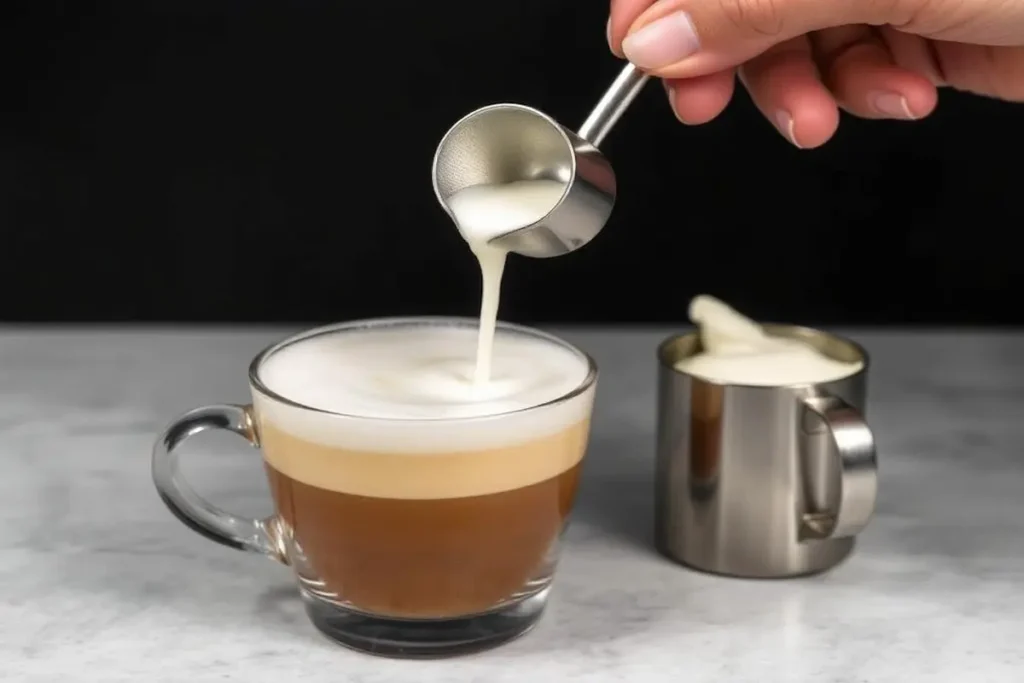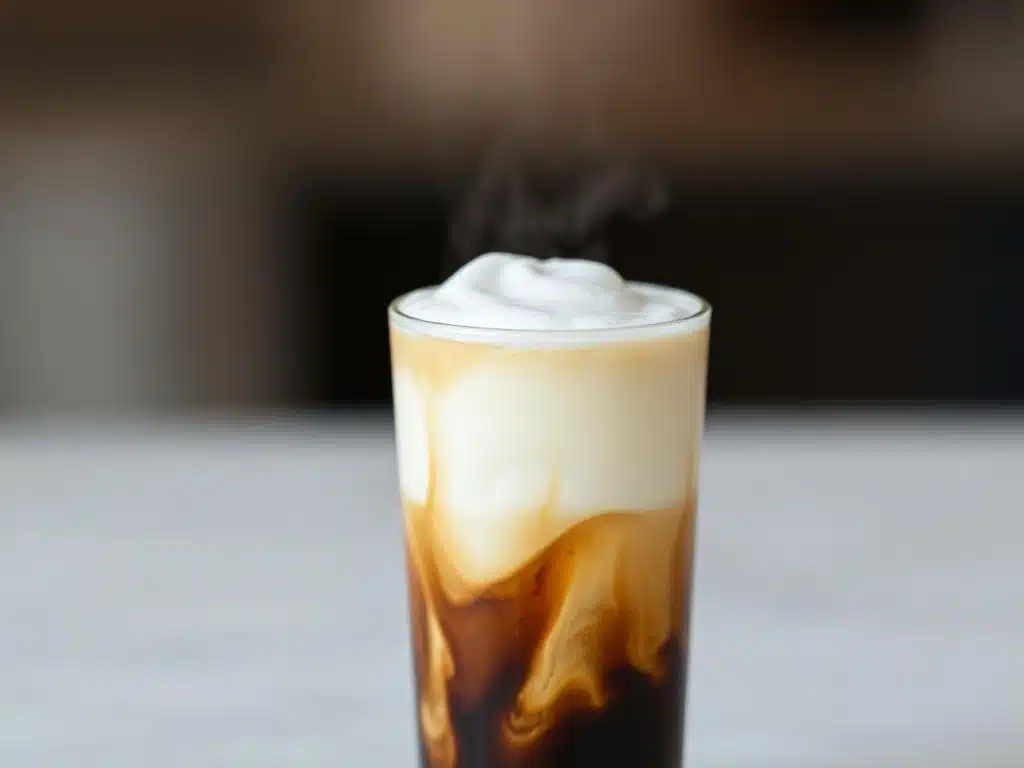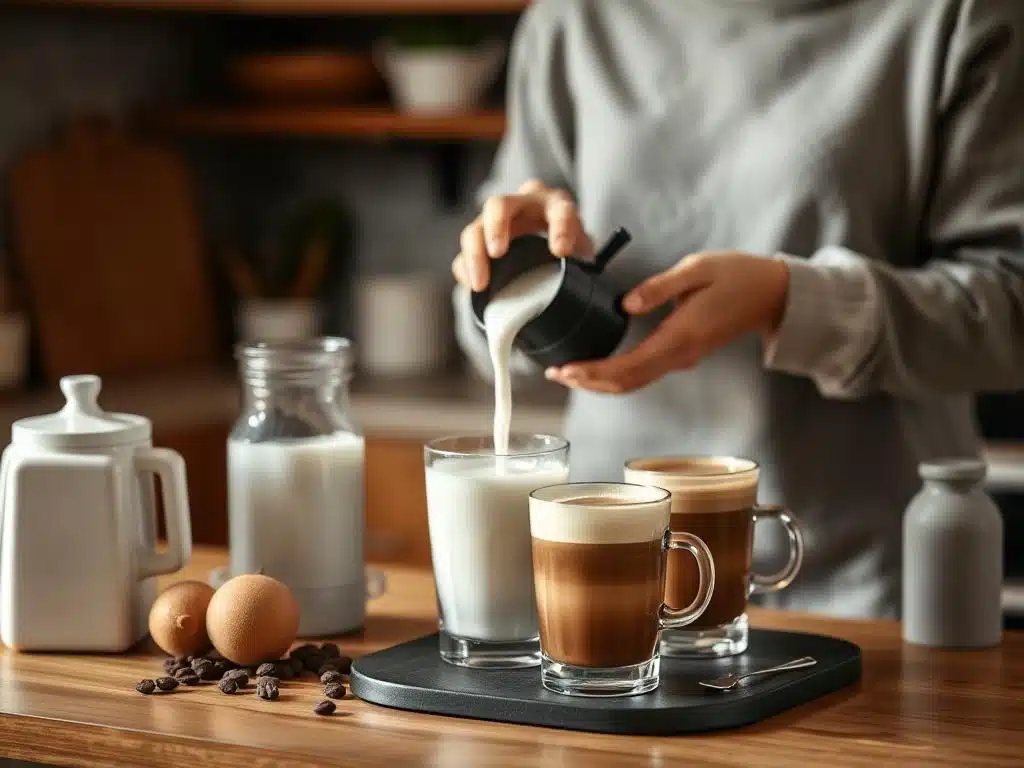Cold foam has taken the coffee world by storm, transforming ordinary drinks into delightful, frothy masterpieces. If you’ve ever sipped a cold brew topped with a luscious layer of foam, you might be wondering, can I use creamer to make cold foam? The answer is a resounding yes! In this article, we’ll dive deep into the world of cold foam, exploring its origins, the science behind it, and how you can easily whip it up at home using creamer. So, grab your frother, and let’s get started!

Introduction
What is Cold Foam?
Cold foam is a light, airy topping made from frothed milk or cream, typically used to enhance cold coffee drinks. Unlike whipped cream, which is thick and rich, cold foam is designed to be fluffy and smooth, creating a delightful texture that complements your beverage without overwhelming it. It’s often used in iced coffees, cold brews, and even teas, adding a touch of elegance and a creamy mouthfeel.
The Rise of Cold Foam in Coffee Shops
In recent years, cold foam has gained immense popularity in coffee shops across the globe. It’s not just a trend; it’s become a staple for many coffee enthusiasts. The introduction of cold foam has allowed baristas to elevate their drinks, offering customers a unique experience that combines flavor and texture. You might have noticed that many cafes now feature cold foam on their menus, often flavored with syrups or spices to enhance the overall taste.
Purpose of the Article
This article aims to answer the burning question: Can I use creamer to make cold foam? We’ll explore the different types of creamers available, how to create cold foam at home, and the various ways you can enjoy it. Whether you’re a coffee aficionado or just someone looking to jazz up your morning routine, this guide will provide you with all the information you need to make delicious cold foam using creamer.
So, let’s dive into the fascinating world of cold foam and discover how you can create this delightful topping right in your kitchen!
Understanding Cold Foam
The Science Behind Cold Foam
To truly appreciate cold foam, it’s essential to understand the science that makes it so special. Cold foam is created by incorporating air into a liquid, which results in a light and airy texture. When you froth milk or creamer, tiny bubbles form, creating that signature foaminess. The key here is to use a liquid that has enough fat content to stabilize those bubbles, allowing the foam to hold its shape.
When you froth creamer, the process is similar to frothing milk, but the results can vary based on the type of creamer you choose. For instance, creamers with higher fat content tend to produce a richer, creamier foam, while lighter options may yield a fluffier texture. This is why many coffee lovers are curious about using creamer to make cold foam it’s all about achieving that perfect balance of flavor and texture.
Ingredients Typically Used for Cold Foam
When it comes to making cold foam, the ingredients you choose can significantly impact the final product. Traditionally, cold foam is made with milk, but many people are now experimenting with various creamers. Here are some common ingredients used for cold foam:
- Milk: Whole milk, skim milk, and even plant-based milks like almond or oat milk can be used. Each type offers a different flavor and texture.
- Creamers: Liquid creamers, powdered creamers, and flavored creamers are all options. They can add a unique twist to your cold foam, enhancing the overall taste of your drink.
- Sweeteners: If you like your foam sweet, consider adding a touch of sugar, flavored syrups, or even honey.
The beauty of cold foam is its versatility. You can mix and match ingredients to create a foam that suits your taste buds perfectly.
The Role of Creamer in Cold Foam
Now, let’s focus on the star of the show: creamer. Many people wonder if they can use creamer to make cold foam, and the answer is yes! Creamers come in various forms liquid, powdered, and flavored and each type can contribute to a different foam experience.
Liquid creamers, especially those with higher fat content, are excellent for creating a rich and creamy cold foam. On the other hand, flavored creamers can add an exciting twist to your drinks, making them more enjoyable. For instance, a vanilla or hazelnut creamer can elevate your cold brew to new heights.
However, it’s essential to consider the nutritional aspects of using creamer. Many creamers contain added sugars and artificial flavors, so if you’re health-conscious, you might want to opt for natural or low-calorie options. Always check the label to ensure you’re making a choice that aligns with your dietary preferences.
Can I Use Creamer to Make Cold Foam?
Types of Creamers Suitable for Cold Foam
When it comes to making cold foam, not all creamers are created equal. The type of creamer you choose can significantly affect the texture and flavor of your foam. Here’s a breakdown of the different types of creamers that work well for creating cold foam:
- Dairy Creamers: These are the traditional options, including half-and-half and heavy cream. They tend to produce a rich, creamy foam that holds its shape well. If you’re looking for a luxurious texture, dairy creamers are your best bet.
- Non-Dairy Creamers: For those who prefer plant-based options, non-dairy creamers made from almond, soy, coconut, or oat milk can also be used. While they may not create as thick a foam as dairy creamers, they can still produce a light and airy texture. Plus, they cater to lactose-intolerant individuals or those following a vegan diet.
- Flavored Creamers: Many brands offer flavored creamers, such as vanilla, hazelnut, or caramel. These can add an exciting twist to your cold foam, enhancing the overall flavor of your drink. Just be mindful of the sweetness level, as some flavored creamers can be quite sugary.
Step-by-Step Guide
Now that you know which creamers work best, let’s dive into the process of making cold foam at home. It’s easier than you might think! Here’s a simple step-by-step guide:
- Gather Your Ingredients and Tools:
- Choose your preferred creamer (dairy or non-dairy).
- You’ll need a frother, blender, or a jar with a lid for shaking.
- Chill Your Creamer:
- For the best results, make sure your creamer is cold. This helps create a better foam. You can even chill your frothing tool if you like.
- Froth the Creamer:
- If you’re using a frother, pour the creamer into a tall container and froth it until it doubles in volume and becomes light and airy. If you’re using a blender, blend on high for about 30 seconds. For the jar method, fill it halfway with creamer, seal it tightly, and shake vigorously for about 30 seconds.
- Check the Consistency:
- The foam should be thick enough to hold its shape but still light and fluffy. If it’s too runny, try frothing it a bit longer.
- Serve Your Cold Foam:
- Gently spoon the cold foam over your favorite iced coffee or cold brew. You can also add a sprinkle of cinnamon or cocoa powder on top for an extra touch.
For a delicious recipe that has garnered over 40,000 shares on Pinterest, check out this Sweet Cream Cold Foam recipe that will elevate your coffee experience!
Tips for Achieving the Best Cold Foam
Creating the perfect cold foam takes a bit of practice, but with these tips, you’ll be well on your way:
- Experiment with Different Creamers: Don’t be afraid to try various creamers to find your favorite flavor and texture. Each type can yield different results, so have fun with it!
- Temperature Matters: Always start with cold creamer. Warm creamer won’t froth as well and can lead to a disappointing foam.
- Frothing Technique: If you’re using a frother, move it up and down in the creamer to incorporate more air. For the jar method, make sure to shake vigorously to create bubbles.
- Sweeten to Taste: If you like your foam sweet, consider adding a bit of sugar or flavored syrup before frothing. This way, the sweetness gets evenly distributed throughout the foam.
Comparing Cold Foam Made with Creamer vs. Milk
Texture and Flavor Differences
When it comes to making cold foam, one of the most common questions is whether to use creamer or milk. Both options can yield delightful results, but they do have distinct differences in texture and flavor.
- Creamer: Using creamer typically results in a richer, creamier foam. The higher fat content in many creamers allows for a denser and more luxurious texture. This can be particularly appealing if you enjoy a more indulgent coffee experience. Additionally, flavored creamers can add a unique twist, enhancing the overall taste of your drink.
- Milk: On the other hand, milk—especially whole milk—can also create a lovely foam, but it tends to be lighter and airier compared to creamer. If you prefer a more subtle flavor, milk might be the way to go. It’s also a great option for those who want a less calorie-dense topping.
Ultimately, the choice between creamer and milk comes down to personal preference. If you’re after a rich, decadent foam, go for creamer. If you prefer something lighter, stick with milk.
Nutritional Comparison
When considering whether to use creamer or milk for your cold foam, it’s essential to look at the nutritional aspects as well. Here’s a quick comparison:
- Creamer: Many creamers, especially flavored ones, can be high in sugar and calories. For instance, a tablespoon of flavored liquid creamer can contain around 30 calories and 5 grams of sugar. If you’re watching your sugar intake, it’s crucial to read the labels and choose options that align with your dietary goals.
- Milk: In contrast, a tablespoon of whole milk contains about 9 calories and less than 1 gram of sugar. If you opt for skim or low-fat milk, the calorie count decreases even further. Milk also provides essential nutrients like calcium and vitamin D, making it a nutritious choice.
In summary, if you’re looking for a richer flavor and texture, creamer is a fantastic option. However, if you’re more health-conscious or prefer a lighter foam, milk might be the better choice.
Cost-Effectiveness
Another factor to consider is cost. Creamers can vary in price, but they often come in larger containers, which can be economical if you use them frequently. However, if you’re only making cold foam occasionally, buying a small carton of milk might be more budget-friendly.
- Creamer: A typical bottle of liquid creamer can range from $3 to $5, depending on the brand and flavor. If you enjoy experimenting with different flavors, this can be a fun investment.
- Milk: A gallon of milk usually costs around $3 to $4, and it can be used for various purposes beyond just cold foam. If you’re a regular milk drinker, this option might be more cost-effective in the long run.
Creative Uses for Cold Foam

Cold Foam in Coffee Drinks
Cold foam isn’t just a pretty topping; it can elevate your coffee drinks to a whole new level! Here are some popular coffee drinks that benefit from a delicious layer of cold foam:
- Iced Coffee: A classic choice! Simply pour your favorite iced coffee over ice and top it with a generous dollop of cold foam. You can even add a splash of flavored syrup to the foam for an extra kick.
- Cold Brew: Cold brew coffee is smooth and rich, making it the perfect base for cold foam. The contrast between the bold coffee and the light, airy foam creates a delightful experience. Try adding a hint of vanilla or caramel syrup to the foam for a sweet twist.
- Iced Lattes: For a refreshing iced latte, combine espresso with cold milk and ice, then crown it with cold foam. This combination offers a creamy texture that balances the strong coffee flavor beautifully.
- Affogato Style: For a fun twist, pour a shot of hot espresso over a scoop of ice cream and top it with cold foam. The hot and cold contrast, along with the creamy foam, makes for a decadent treat.
Cold Foam in Other Beverages
Cold foam isn’t limited to just coffee drinks! Here are some creative ways to incorporate cold foam into other beverages:
- Iced Tea: Cold foam can add a delightful creaminess to iced tea. Brew your favorite tea, chill it, and then top it with cold foam. Consider adding a splash of lemon or a hint of honey for added flavor.
- Smoothies: Want to make your smoothies even more indulgent? Top your favorite fruit smoothie with cold foam. It adds a creamy texture and makes the drink feel more like a dessert.
- Milkshakes: For a fun twist on traditional milkshakes, try adding cold foam on top. Blend your favorite ice cream with milk, pour it into a glass, and finish it off with a generous layer of cold foam. You can even sprinkle some crushed cookies or chocolate shavings on top for extra flair.
Innovative Recipes to Try at Home
Feeling inspired? Here are a couple of innovative recipes to get you started with cold foam:
- Vanilla Cold Foam Iced Coffee:
- Brew a strong cup of coffee and let it cool.
- Fill a glass with ice and pour the coffee over it.
- In a separate container, froth together 1/2 cup of vanilla creamer and a splash of vanilla syrup until light and fluffy.
- Spoon the cold foam over the iced coffee and enjoy!
- Matcha Cold Foam Latte:
- Whisk together 1 teaspoon of matcha powder with a splash of hot water until smooth.
- Fill a glass with ice and pour in your choice of milk (dairy or non-dairy).
- Froth 1/2 cup of creamer until it’s light and airy, then gently fold in the matcha mixture.
- Top your iced milk with the matcha cold foam for a refreshing treat.
Frequently Asked Questions About Cold Foam
1. Can I make cold foam without a frother?
Absolutely! While a frother is a convenient tool for creating cold foam, it’s not the only option. Here are a few alternative methods:
- Blender: You can use a blender to froth your creamer. Blend on high for about 30 seconds until you achieve the desired foam consistency.
- Jar Method: Pour your cold creamer into a jar, filling it halfway. Seal the jar tightly and shake vigorously for about 30 seconds. This method can create a decent amount of foam, though it may not be as stable as using a frother.
- Whisk: If you have a whisk and some elbow grease, you can froth the creamer by hand. Whisk vigorously until you see bubbles forming and the mixture thickens.
2. How long does cold foam last?
Cold foam is best enjoyed fresh, as it tends to lose its airy texture over time. Ideally, you should use it immediately after frothing. If you need to store it, keep it in the refrigerator for up to a few hours, but be aware that it may deflate and lose its fluffiness.
3. Can I sweeten my cold foam?
Yes! You can sweeten your cold foam to your liking. Consider adding sugar, flavored syrups, or even a splash of vanilla extract before frothing. Just remember that flavored creamers often contain added sugars, so adjust accordingly based on your taste preferences.
4. Is cold foam the same as whipped cream?
No, cold foam and whipped cream are quite different. Cold foam is light and airy, designed to sit atop cold beverages without being overly heavy. Whipped cream, on the other hand, is thicker and richer, often used as a topping for desserts. While both can enhance your drinks, they provide different textures and flavors.
5. Can I use flavored creamers for cold foam?
Absolutely! Flavored creamers can add a delightful twist to your cold foam. Whether you choose vanilla, hazelnut, caramel, or any other flavor, it can enhance the overall taste of your beverage. Just be mindful of the sweetness level, as some flavored creamers can be quite sugary.
6. Can I make cold foam with non-dairy creamers?
Yes, non-dairy creamers can be used to make cold foam! Options like almond, soy, coconut, and oat milk can all create a light and airy foam. Keep in mind that the texture may vary depending on the type of non-dairy creamer you choose, so it may take some experimentation to find your favorite.
7. How can I make my cold foam more stable?
To achieve a more stable cold foam, consider using creamers with higher fat content, such as heavy cream or half-and-half. Additionally, frothing for a longer period can help incorporate more air, resulting in a denser foam. If you want to experiment further, you can also try adding a small amount of powdered sugar or a stabilizer like gelatin, though this is less common for cold foam.
8. Can I use cold foam in hot drinks?
While cold foam is primarily designed for cold beverages, you can experiment with using it in hot drinks. However, keep in mind that the foam may dissolve more quickly in hot liquids. If you want to try it, consider adding cold foam to a hot drink just before serving to maintain its texture for a little longer.
Conclusion
Cold foam is a delightful addition to a variety of beverages, and using creamer to create it opens up a world of flavor possibilities. Whether you prefer the richness of dairy creamers or the lightness of non-dairy options, you can easily whip up this frothy topping at home. With the tips, recipes, and answers to common questions provided in this guide, you’re now equipped to enjoy cold foam in all its glory.
So go ahead, get creative, and elevate your coffee and beverage experience with delicious cold foam! Enjoy your frothy creations, and don’t hesitate to experiment with different flavors and combinations. Happy sipping!
Cold foam has become a popular addition to coffee drinks, offering a light and airy texture that enhances the overall experience. When combined with creamer, it creates a velvety layer that not only adds creaminess but also a touch of sweetness to your favorite iced beverages. This delightful topping is perfect for those who enjoy a little indulgence without overwhelming their drink with sugar. For more insights into the benefits of incorporating creamy textures into your diet, check out this informative article on the health benefits of dairy.

